Strategic Leadership: A Critical Analysis of Steve Jobs' Leadership
VerifiedAdded on 2023/06/07
|10
|2986
|172
Report
AI Summary
This report provides a strategic analysis of Steve Jobs' leadership, examining his behaviors, skills, and relevance to leadership theories, particularly transformational leadership. It discusses his successes and failures, strengths and weaknesses, and addresses issues of ethics in his leadership style. The report highlights Jobs' innovative vision, communication skills, and the impact of his leadership on Apple Inc. and various industries. It also acknowledges his negative traits, such as his manipulative behavior and authoritative approach. Furthermore, it discusses the importance of ethical leadership and makes recommendations for future leaders based on the analysis of Steve Jobs' career. Desklib provides similar solved assignments for students.
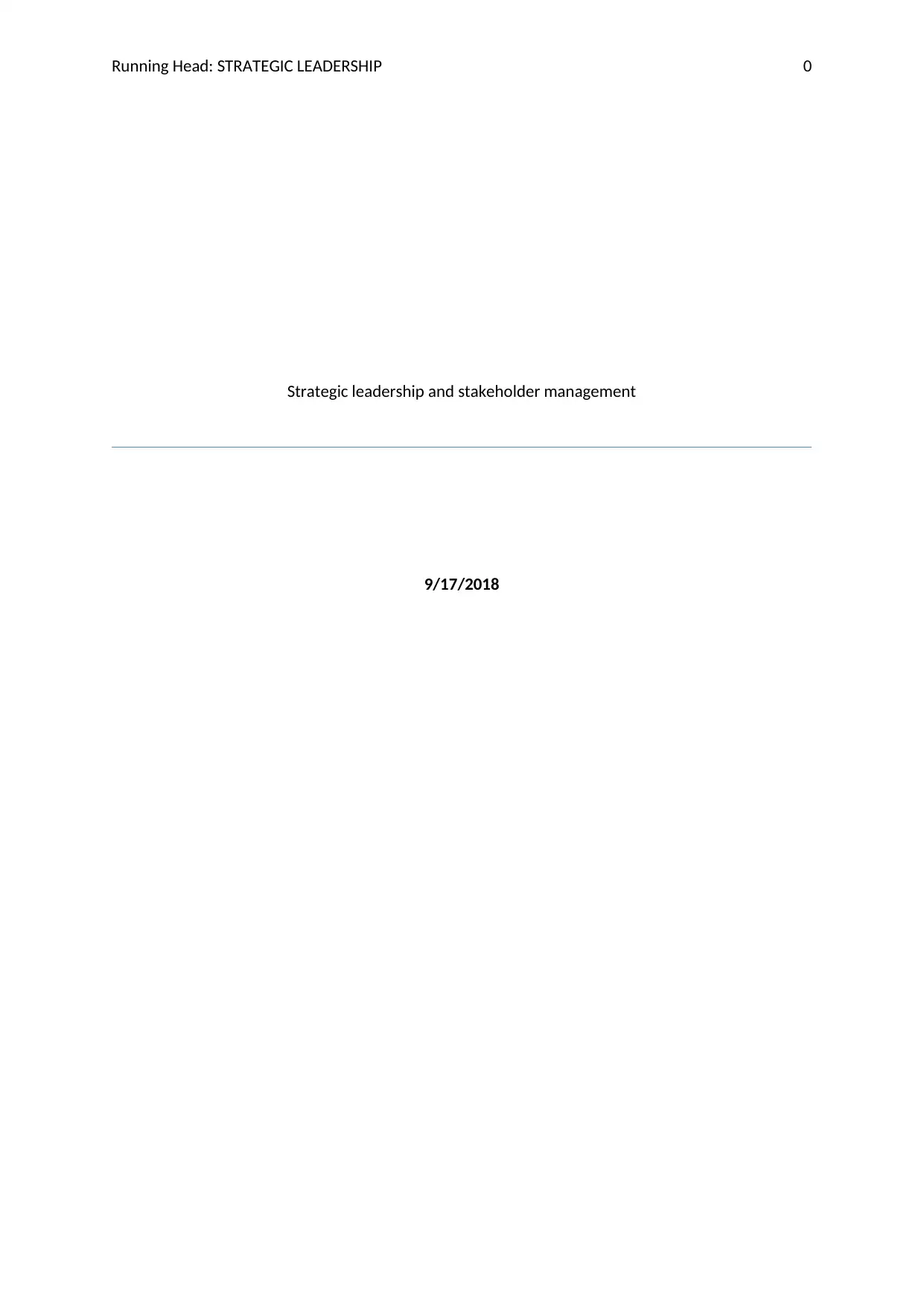
Running Head: STRATEGIC LEADERSHIP 0
Strategic leadership and stakeholder management
9/17/2018
Strategic leadership and stakeholder management
9/17/2018
Paraphrase This Document
Need a fresh take? Get an instant paraphrase of this document with our AI Paraphraser
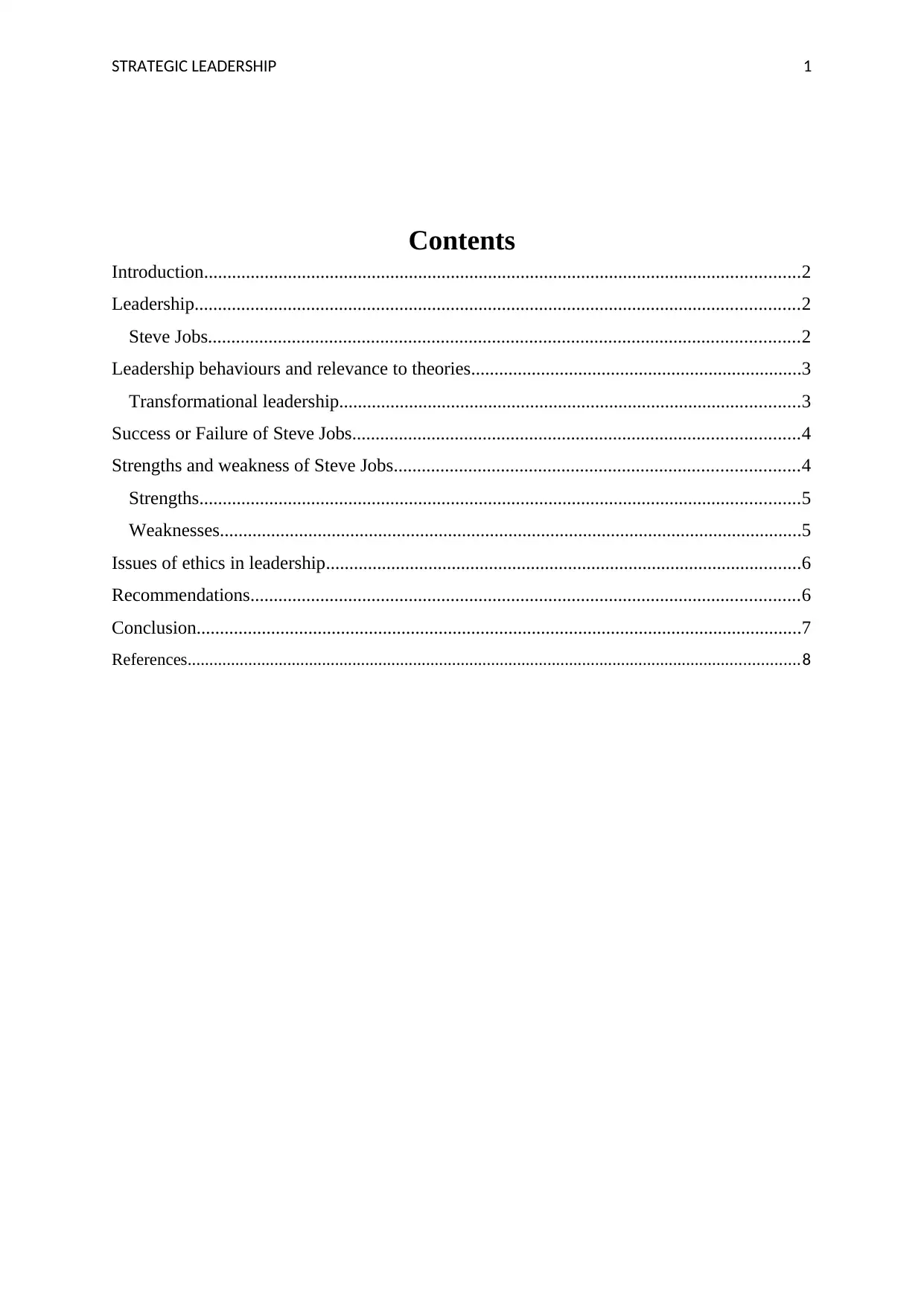
STRATEGIC LEADERSHIP 1
Contents
Introduction................................................................................................................................2
Leadership..................................................................................................................................2
Steve Jobs...............................................................................................................................2
Leadership behaviours and relevance to theories.......................................................................3
Transformational leadership...................................................................................................3
Success or Failure of Steve Jobs................................................................................................4
Strengths and weakness of Steve Jobs.......................................................................................4
Strengths.................................................................................................................................5
Weaknesses.............................................................................................................................5
Issues of ethics in leadership......................................................................................................6
Recommendations......................................................................................................................6
Conclusion..................................................................................................................................7
References.............................................................................................................................................8
Contents
Introduction................................................................................................................................2
Leadership..................................................................................................................................2
Steve Jobs...............................................................................................................................2
Leadership behaviours and relevance to theories.......................................................................3
Transformational leadership...................................................................................................3
Success or Failure of Steve Jobs................................................................................................4
Strengths and weakness of Steve Jobs.......................................................................................4
Strengths.................................................................................................................................5
Weaknesses.............................................................................................................................5
Issues of ethics in leadership......................................................................................................6
Recommendations......................................................................................................................6
Conclusion..................................................................................................................................7
References.............................................................................................................................................8
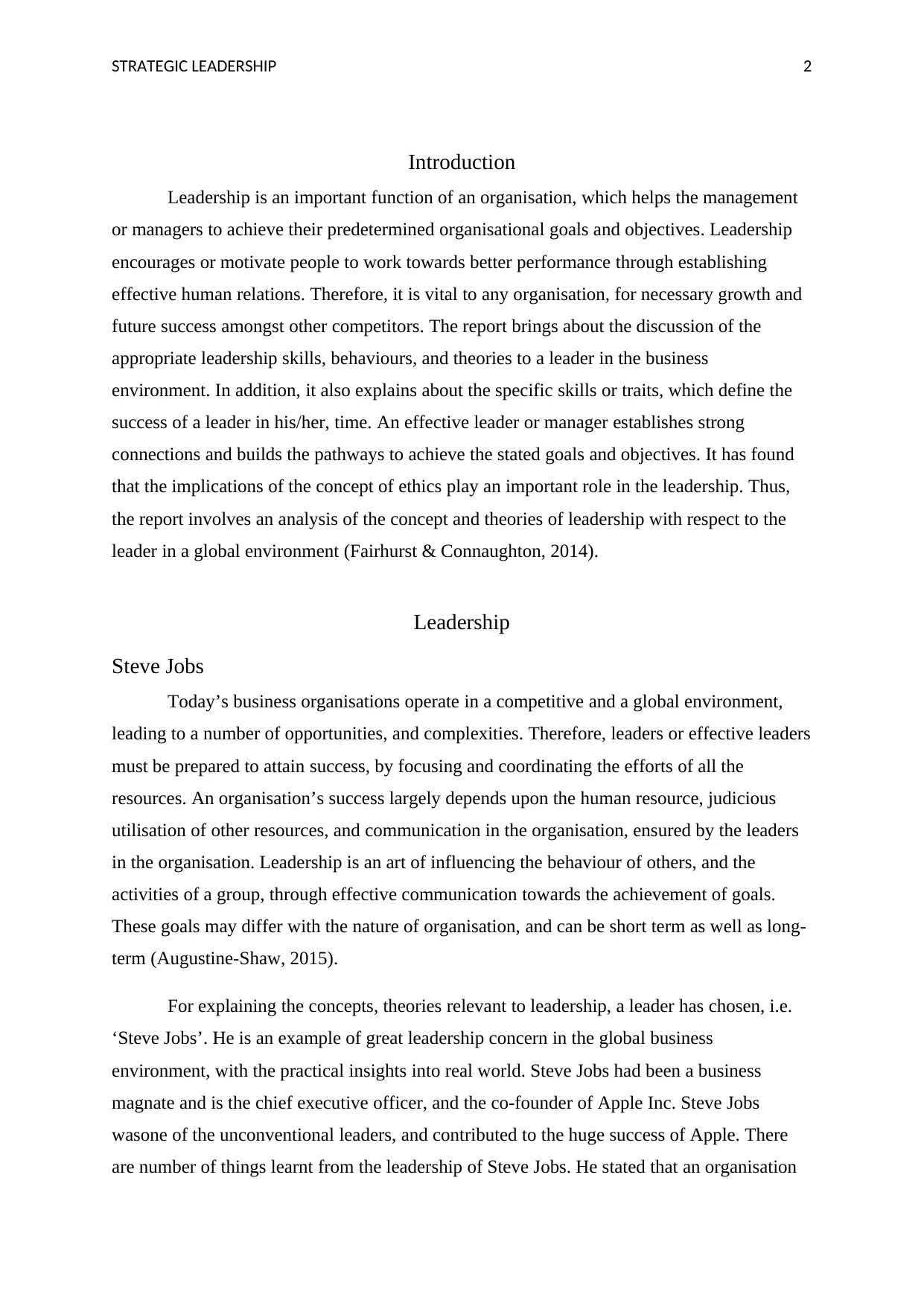
STRATEGIC LEADERSHIP 2
Introduction
Leadership is an important function of an organisation, which helps the management
or managers to achieve their predetermined organisational goals and objectives. Leadership
encourages or motivate people to work towards better performance through establishing
effective human relations. Therefore, it is vital to any organisation, for necessary growth and
future success amongst other competitors. The report brings about the discussion of the
appropriate leadership skills, behaviours, and theories to a leader in the business
environment. In addition, it also explains about the specific skills or traits, which define the
success of a leader in his/her, time. An effective leader or manager establishes strong
connections and builds the pathways to achieve the stated goals and objectives. It has found
that the implications of the concept of ethics play an important role in the leadership. Thus,
the report involves an analysis of the concept and theories of leadership with respect to the
leader in a global environment (Fairhurst & Connaughton, 2014).
Leadership
Steve Jobs
Today’s business organisations operate in a competitive and a global environment,
leading to a number of opportunities, and complexities. Therefore, leaders or effective leaders
must be prepared to attain success, by focusing and coordinating the efforts of all the
resources. An organisation’s success largely depends upon the human resource, judicious
utilisation of other resources, and communication in the organisation, ensured by the leaders
in the organisation. Leadership is an art of influencing the behaviour of others, and the
activities of a group, through effective communication towards the achievement of goals.
These goals may differ with the nature of organisation, and can be short term as well as long-
term (Augustine-Shaw, 2015).
For explaining the concepts, theories relevant to leadership, a leader has chosen, i.e.
‘Steve Jobs’. He is an example of great leadership concern in the global business
environment, with the practical insights into real world. Steve Jobs had been a business
magnate and is the chief executive officer, and the co-founder of Apple Inc. Steve Jobs
wasone of the unconventional leaders, and contributed to the huge success of Apple. There
are number of things learnt from the leadership of Steve Jobs. He stated that an organisation
Introduction
Leadership is an important function of an organisation, which helps the management
or managers to achieve their predetermined organisational goals and objectives. Leadership
encourages or motivate people to work towards better performance through establishing
effective human relations. Therefore, it is vital to any organisation, for necessary growth and
future success amongst other competitors. The report brings about the discussion of the
appropriate leadership skills, behaviours, and theories to a leader in the business
environment. In addition, it also explains about the specific skills or traits, which define the
success of a leader in his/her, time. An effective leader or manager establishes strong
connections and builds the pathways to achieve the stated goals and objectives. It has found
that the implications of the concept of ethics play an important role in the leadership. Thus,
the report involves an analysis of the concept and theories of leadership with respect to the
leader in a global environment (Fairhurst & Connaughton, 2014).
Leadership
Steve Jobs
Today’s business organisations operate in a competitive and a global environment,
leading to a number of opportunities, and complexities. Therefore, leaders or effective leaders
must be prepared to attain success, by focusing and coordinating the efforts of all the
resources. An organisation’s success largely depends upon the human resource, judicious
utilisation of other resources, and communication in the organisation, ensured by the leaders
in the organisation. Leadership is an art of influencing the behaviour of others, and the
activities of a group, through effective communication towards the achievement of goals.
These goals may differ with the nature of organisation, and can be short term as well as long-
term (Augustine-Shaw, 2015).
For explaining the concepts, theories relevant to leadership, a leader has chosen, i.e.
‘Steve Jobs’. He is an example of great leadership concern in the global business
environment, with the practical insights into real world. Steve Jobs had been a business
magnate and is the chief executive officer, and the co-founder of Apple Inc. Steve Jobs
wasone of the unconventional leaders, and contributed to the huge success of Apple. There
are number of things learnt from the leadership of Steve Jobs. He stated that an organisation
⊘ This is a preview!⊘
Do you want full access?
Subscribe today to unlock all pages.

Trusted by 1+ million students worldwide
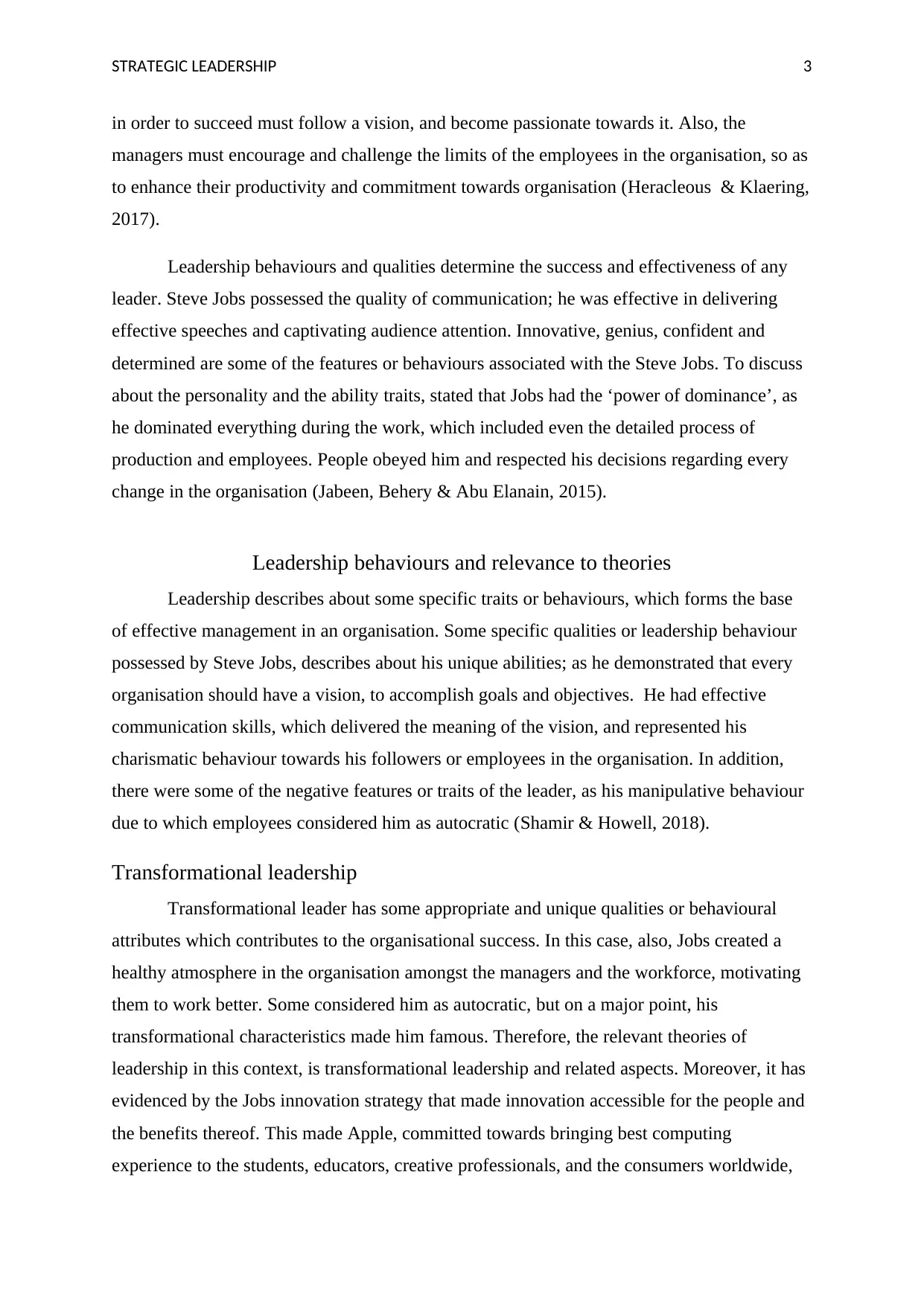
STRATEGIC LEADERSHIP 3
in order to succeed must follow a vision, and become passionate towards it. Also, the
managers must encourage and challenge the limits of the employees in the organisation, so as
to enhance their productivity and commitment towards organisation (Heracleous & Klaering,
2017).
Leadership behaviours and qualities determine the success and effectiveness of any
leader. Steve Jobs possessed the quality of communication; he was effective in delivering
effective speeches and captivating audience attention. Innovative, genius, confident and
determined are some of the features or behaviours associated with the Steve Jobs. To discuss
about the personality and the ability traits, stated that Jobs had the ‘power of dominance’, as
he dominated everything during the work, which included even the detailed process of
production and employees. People obeyed him and respected his decisions regarding every
change in the organisation (Jabeen, Behery & Abu Elanain, 2015).
Leadership behaviours and relevance to theories
Leadership describes about some specific traits or behaviours, which forms the base
of effective management in an organisation. Some specific qualities or leadership behaviour
possessed by Steve Jobs, describes about his unique abilities; as he demonstrated that every
organisation should have a vision, to accomplish goals and objectives. He had effective
communication skills, which delivered the meaning of the vision, and represented his
charismatic behaviour towards his followers or employees in the organisation. In addition,
there were some of the negative features or traits of the leader, as his manipulative behaviour
due to which employees considered him as autocratic (Shamir & Howell, 2018).
Transformational leadership
Transformational leader has some appropriate and unique qualities or behavioural
attributes which contributes to the organisational success. In this case, also, Jobs created a
healthy atmosphere in the organisation amongst the managers and the workforce, motivating
them to work better. Some considered him as autocratic, but on a major point, his
transformational characteristics made him famous. Therefore, the relevant theories of
leadership in this context, is transformational leadership and related aspects. Moreover, it has
evidenced by the Jobs innovation strategy that made innovation accessible for the people and
the benefits thereof. This made Apple, committed towards bringing best computing
experience to the students, educators, creative professionals, and the consumers worldwide,
in order to succeed must follow a vision, and become passionate towards it. Also, the
managers must encourage and challenge the limits of the employees in the organisation, so as
to enhance their productivity and commitment towards organisation (Heracleous & Klaering,
2017).
Leadership behaviours and qualities determine the success and effectiveness of any
leader. Steve Jobs possessed the quality of communication; he was effective in delivering
effective speeches and captivating audience attention. Innovative, genius, confident and
determined are some of the features or behaviours associated with the Steve Jobs. To discuss
about the personality and the ability traits, stated that Jobs had the ‘power of dominance’, as
he dominated everything during the work, which included even the detailed process of
production and employees. People obeyed him and respected his decisions regarding every
change in the organisation (Jabeen, Behery & Abu Elanain, 2015).
Leadership behaviours and relevance to theories
Leadership describes about some specific traits or behaviours, which forms the base
of effective management in an organisation. Some specific qualities or leadership behaviour
possessed by Steve Jobs, describes about his unique abilities; as he demonstrated that every
organisation should have a vision, to accomplish goals and objectives. He had effective
communication skills, which delivered the meaning of the vision, and represented his
charismatic behaviour towards his followers or employees in the organisation. In addition,
there were some of the negative features or traits of the leader, as his manipulative behaviour
due to which employees considered him as autocratic (Shamir & Howell, 2018).
Transformational leadership
Transformational leader has some appropriate and unique qualities or behavioural
attributes which contributes to the organisational success. In this case, also, Jobs created a
healthy atmosphere in the organisation amongst the managers and the workforce, motivating
them to work better. Some considered him as autocratic, but on a major point, his
transformational characteristics made him famous. Therefore, the relevant theories of
leadership in this context, is transformational leadership and related aspects. Moreover, it has
evidenced by the Jobs innovation strategy that made innovation accessible for the people and
the benefits thereof. This made Apple, committed towards bringing best computing
experience to the students, educators, creative professionals, and the consumers worldwide,
Paraphrase This Document
Need a fresh take? Get an instant paraphrase of this document with our AI Paraphraser
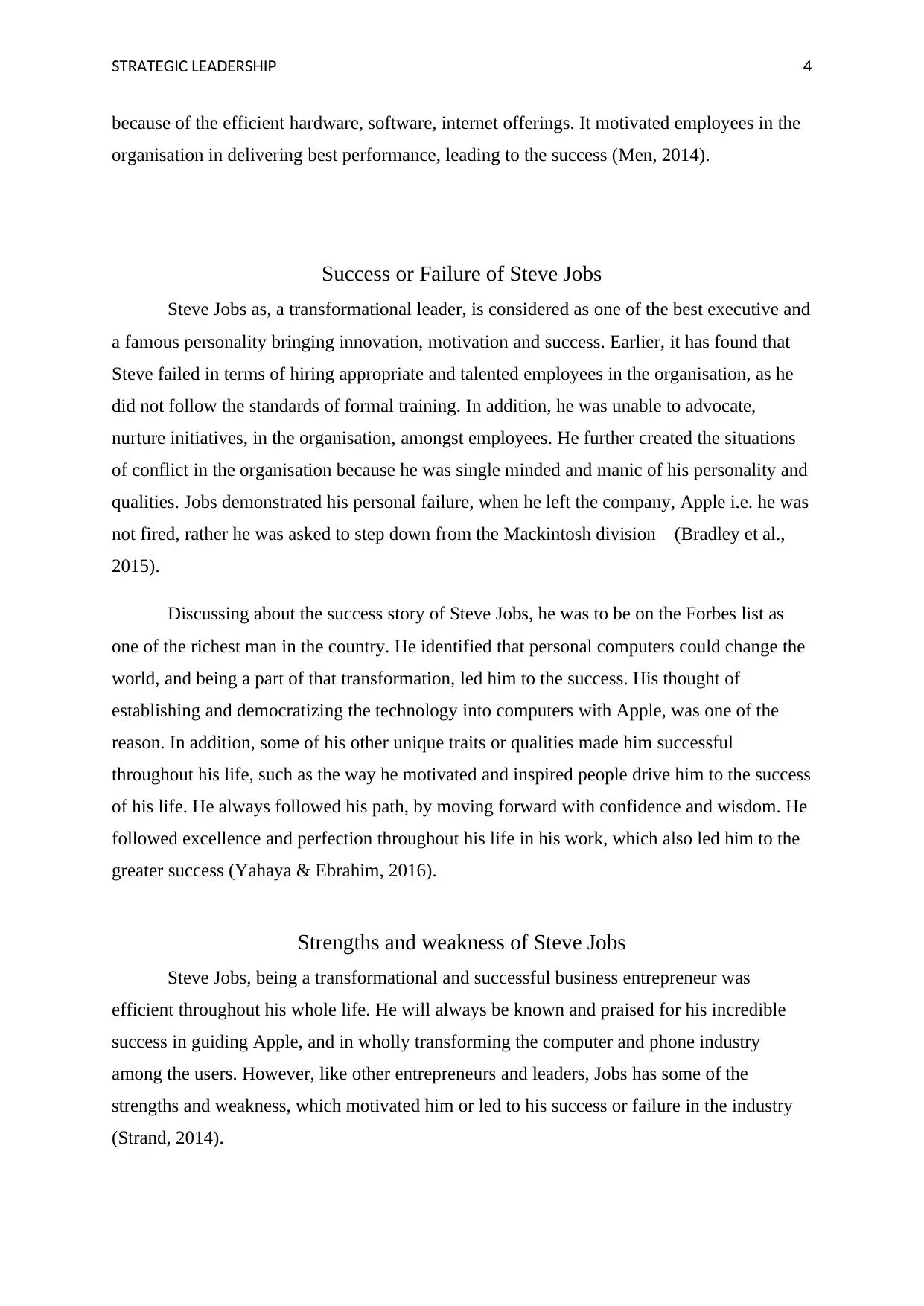
STRATEGIC LEADERSHIP 4
because of the efficient hardware, software, internet offerings. It motivated employees in the
organisation in delivering best performance, leading to the success (Men, 2014).
Success or Failure of Steve Jobs
Steve Jobs as, a transformational leader, is considered as one of the best executive and
a famous personality bringing innovation, motivation and success. Earlier, it has found that
Steve failed in terms of hiring appropriate and talented employees in the organisation, as he
did not follow the standards of formal training. In addition, he was unable to advocate,
nurture initiatives, in the organisation, amongst employees. He further created the situations
of conflict in the organisation because he was single minded and manic of his personality and
qualities. Jobs demonstrated his personal failure, when he left the company, Apple i.e. he was
not fired, rather he was asked to step down from the Mackintosh division (Bradley et al.,
2015).
Discussing about the success story of Steve Jobs, he was to be on the Forbes list as
one of the richest man in the country. He identified that personal computers could change the
world, and being a part of that transformation, led him to the success. His thought of
establishing and democratizing the technology into computers with Apple, was one of the
reason. In addition, some of his other unique traits or qualities made him successful
throughout his life, such as the way he motivated and inspired people drive him to the success
of his life. He always followed his path, by moving forward with confidence and wisdom. He
followed excellence and perfection throughout his life in his work, which also led him to the
greater success (Yahaya & Ebrahim, 2016).
Strengths and weakness of Steve Jobs
Steve Jobs, being a transformational and successful business entrepreneur was
efficient throughout his whole life. He will always be known and praised for his incredible
success in guiding Apple, and in wholly transforming the computer and phone industry
among the users. However, like other entrepreneurs and leaders, Jobs has some of the
strengths and weakness, which motivated him or led to his success or failure in the industry
(Strand, 2014).
because of the efficient hardware, software, internet offerings. It motivated employees in the
organisation in delivering best performance, leading to the success (Men, 2014).
Success or Failure of Steve Jobs
Steve Jobs as, a transformational leader, is considered as one of the best executive and
a famous personality bringing innovation, motivation and success. Earlier, it has found that
Steve failed in terms of hiring appropriate and talented employees in the organisation, as he
did not follow the standards of formal training. In addition, he was unable to advocate,
nurture initiatives, in the organisation, amongst employees. He further created the situations
of conflict in the organisation because he was single minded and manic of his personality and
qualities. Jobs demonstrated his personal failure, when he left the company, Apple i.e. he was
not fired, rather he was asked to step down from the Mackintosh division (Bradley et al.,
2015).
Discussing about the success story of Steve Jobs, he was to be on the Forbes list as
one of the richest man in the country. He identified that personal computers could change the
world, and being a part of that transformation, led him to the success. His thought of
establishing and democratizing the technology into computers with Apple, was one of the
reason. In addition, some of his other unique traits or qualities made him successful
throughout his life, such as the way he motivated and inspired people drive him to the success
of his life. He always followed his path, by moving forward with confidence and wisdom. He
followed excellence and perfection throughout his life in his work, which also led him to the
greater success (Yahaya & Ebrahim, 2016).
Strengths and weakness of Steve Jobs
Steve Jobs, being a transformational and successful business entrepreneur was
efficient throughout his whole life. He will always be known and praised for his incredible
success in guiding Apple, and in wholly transforming the computer and phone industry
among the users. However, like other entrepreneurs and leaders, Jobs has some of the
strengths and weakness, which motivated him or led to his success or failure in the industry
(Strand, 2014).
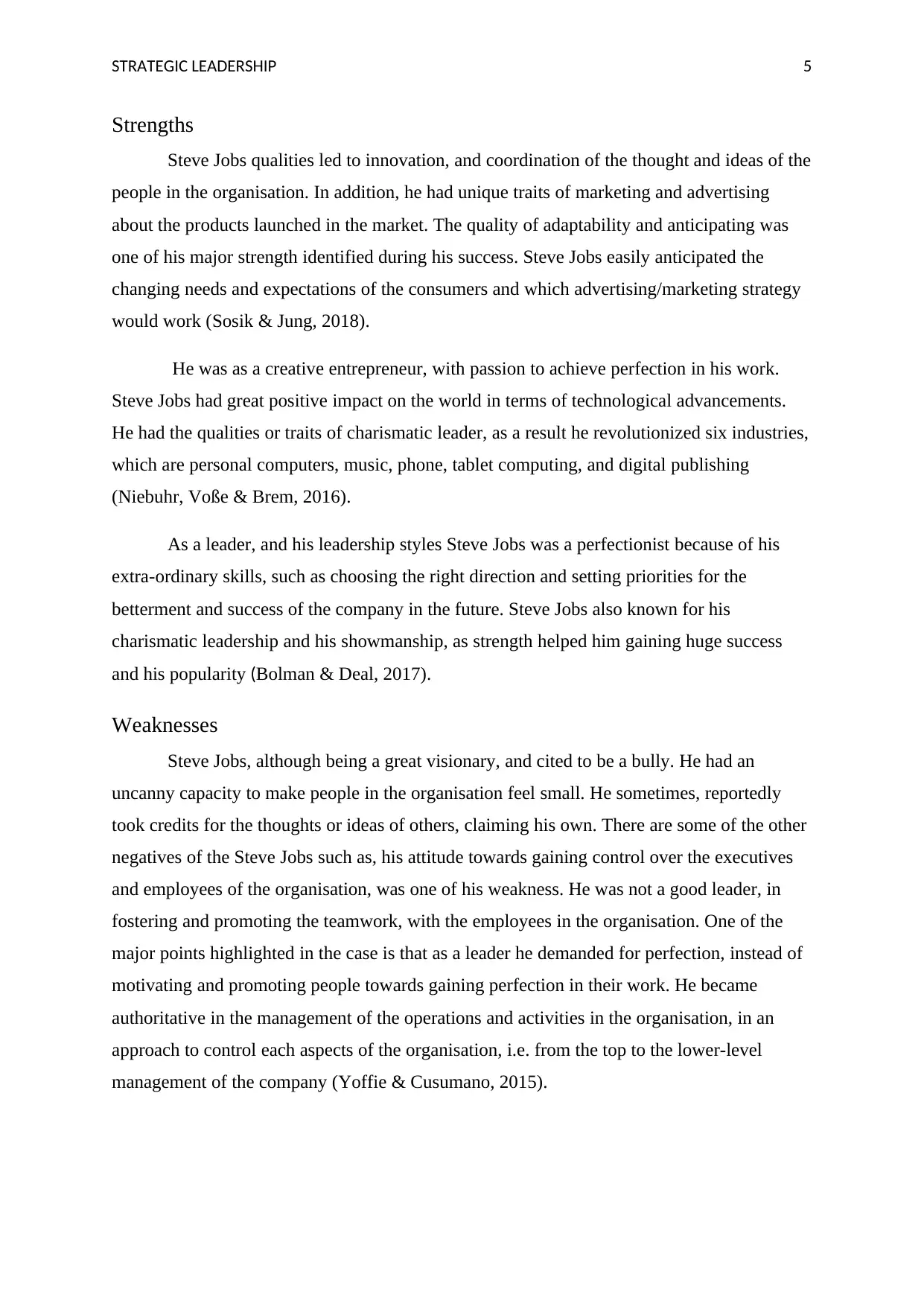
STRATEGIC LEADERSHIP 5
Strengths
Steve Jobs qualities led to innovation, and coordination of the thought and ideas of the
people in the organisation. In addition, he had unique traits of marketing and advertising
about the products launched in the market. The quality of adaptability and anticipating was
one of his major strength identified during his success. Steve Jobs easily anticipated the
changing needs and expectations of the consumers and which advertising/marketing strategy
would work (Sosik & Jung, 2018).
He was as a creative entrepreneur, with passion to achieve perfection in his work.
Steve Jobs had great positive impact on the world in terms of technological advancements.
He had the qualities or traits of charismatic leader, as a result he revolutionized six industries,
which are personal computers, music, phone, tablet computing, and digital publishing
(Niebuhr, Voße & Brem, 2016).
As a leader, and his leadership styles Steve Jobs was a perfectionist because of his
extra-ordinary skills, such as choosing the right direction and setting priorities for the
betterment and success of the company in the future. Steve Jobs also known for his
charismatic leadership and his showmanship, as strength helped him gaining huge success
and his popularity (Bolman & Deal, 2017).
Weaknesses
Steve Jobs, although being a great visionary, and cited to be a bully. He had an
uncanny capacity to make people in the organisation feel small. He sometimes, reportedly
took credits for the thoughts or ideas of others, claiming his own. There are some of the other
negatives of the Steve Jobs such as, his attitude towards gaining control over the executives
and employees of the organisation, was one of his weakness. He was not a good leader, in
fostering and promoting the teamwork, with the employees in the organisation. One of the
major points highlighted in the case is that as a leader he demanded for perfection, instead of
motivating and promoting people towards gaining perfection in their work. He became
authoritative in the management of the operations and activities in the organisation, in an
approach to control each aspects of the organisation, i.e. from the top to the lower-level
management of the company (Yoffie & Cusumano, 2015).
Strengths
Steve Jobs qualities led to innovation, and coordination of the thought and ideas of the
people in the organisation. In addition, he had unique traits of marketing and advertising
about the products launched in the market. The quality of adaptability and anticipating was
one of his major strength identified during his success. Steve Jobs easily anticipated the
changing needs and expectations of the consumers and which advertising/marketing strategy
would work (Sosik & Jung, 2018).
He was as a creative entrepreneur, with passion to achieve perfection in his work.
Steve Jobs had great positive impact on the world in terms of technological advancements.
He had the qualities or traits of charismatic leader, as a result he revolutionized six industries,
which are personal computers, music, phone, tablet computing, and digital publishing
(Niebuhr, Voße & Brem, 2016).
As a leader, and his leadership styles Steve Jobs was a perfectionist because of his
extra-ordinary skills, such as choosing the right direction and setting priorities for the
betterment and success of the company in the future. Steve Jobs also known for his
charismatic leadership and his showmanship, as strength helped him gaining huge success
and his popularity (Bolman & Deal, 2017).
Weaknesses
Steve Jobs, although being a great visionary, and cited to be a bully. He had an
uncanny capacity to make people in the organisation feel small. He sometimes, reportedly
took credits for the thoughts or ideas of others, claiming his own. There are some of the other
negatives of the Steve Jobs such as, his attitude towards gaining control over the executives
and employees of the organisation, was one of his weakness. He was not a good leader, in
fostering and promoting the teamwork, with the employees in the organisation. One of the
major points highlighted in the case is that as a leader he demanded for perfection, instead of
motivating and promoting people towards gaining perfection in their work. He became
authoritative in the management of the operations and activities in the organisation, in an
approach to control each aspects of the organisation, i.e. from the top to the lower-level
management of the company (Yoffie & Cusumano, 2015).
⊘ This is a preview!⊘
Do you want full access?
Subscribe today to unlock all pages.

Trusted by 1+ million students worldwide
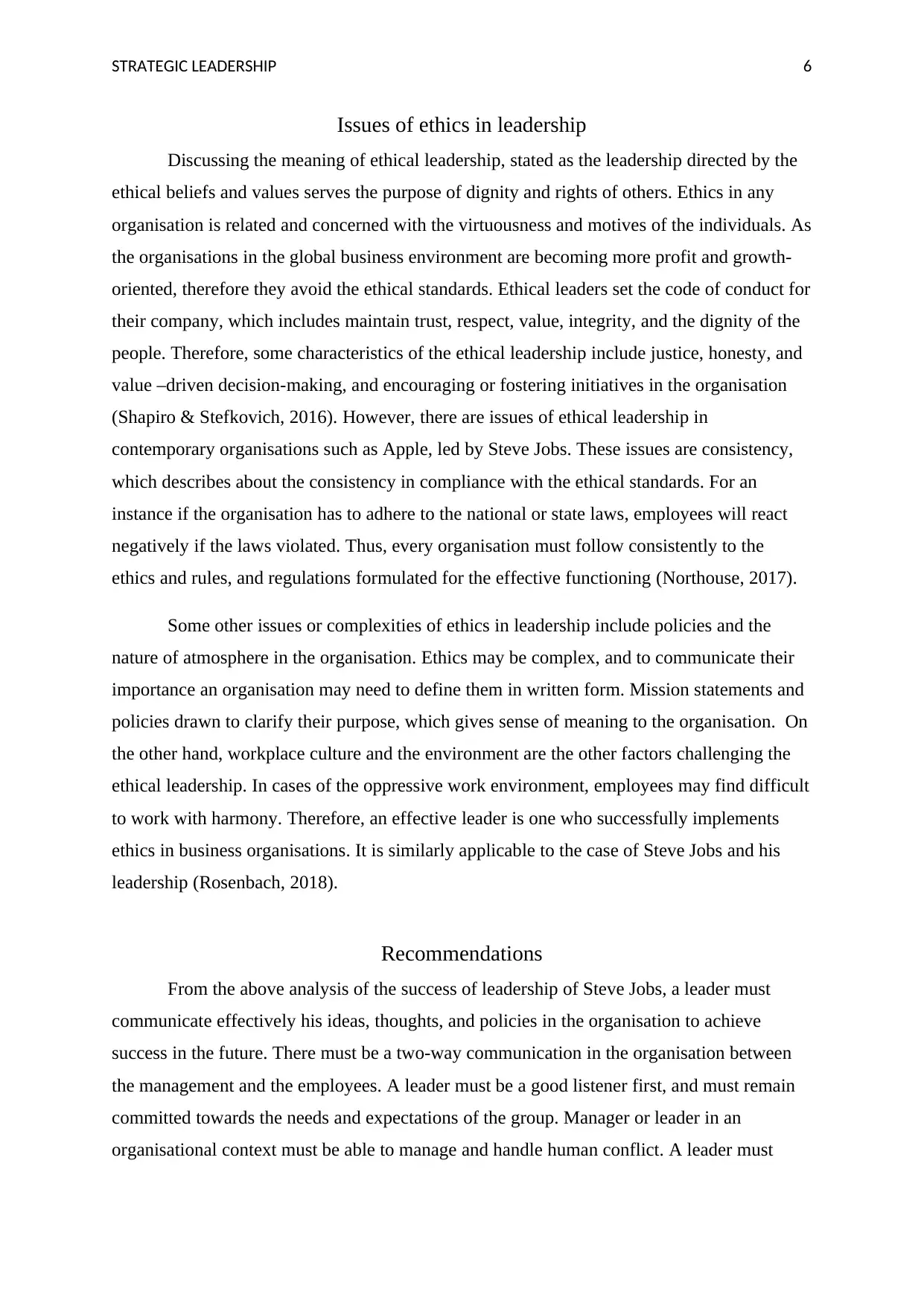
STRATEGIC LEADERSHIP 6
Issues of ethics in leadership
Discussing the meaning of ethical leadership, stated as the leadership directed by the
ethical beliefs and values serves the purpose of dignity and rights of others. Ethics in any
organisation is related and concerned with the virtuousness and motives of the individuals. As
the organisations in the global business environment are becoming more profit and growth-
oriented, therefore they avoid the ethical standards. Ethical leaders set the code of conduct for
their company, which includes maintain trust, respect, value, integrity, and the dignity of the
people. Therefore, some characteristics of the ethical leadership include justice, honesty, and
value –driven decision-making, and encouraging or fostering initiatives in the organisation
(Shapiro & Stefkovich, 2016). However, there are issues of ethical leadership in
contemporary organisations such as Apple, led by Steve Jobs. These issues are consistency,
which describes about the consistency in compliance with the ethical standards. For an
instance if the organisation has to adhere to the national or state laws, employees will react
negatively if the laws violated. Thus, every organisation must follow consistently to the
ethics and rules, and regulations formulated for the effective functioning (Northouse, 2017).
Some other issues or complexities of ethics in leadership include policies and the
nature of atmosphere in the organisation. Ethics may be complex, and to communicate their
importance an organisation may need to define them in written form. Mission statements and
policies drawn to clarify their purpose, which gives sense of meaning to the organisation. On
the other hand, workplace culture and the environment are the other factors challenging the
ethical leadership. In cases of the oppressive work environment, employees may find difficult
to work with harmony. Therefore, an effective leader is one who successfully implements
ethics in business organisations. It is similarly applicable to the case of Steve Jobs and his
leadership (Rosenbach, 2018).
Recommendations
From the above analysis of the success of leadership of Steve Jobs, a leader must
communicate effectively his ideas, thoughts, and policies in the organisation to achieve
success in the future. There must be a two-way communication in the organisation between
the management and the employees. A leader must be a good listener first, and must remain
committed towards the needs and expectations of the group. Manager or leader in an
organisational context must be able to manage and handle human conflict. A leader must
Issues of ethics in leadership
Discussing the meaning of ethical leadership, stated as the leadership directed by the
ethical beliefs and values serves the purpose of dignity and rights of others. Ethics in any
organisation is related and concerned with the virtuousness and motives of the individuals. As
the organisations in the global business environment are becoming more profit and growth-
oriented, therefore they avoid the ethical standards. Ethical leaders set the code of conduct for
their company, which includes maintain trust, respect, value, integrity, and the dignity of the
people. Therefore, some characteristics of the ethical leadership include justice, honesty, and
value –driven decision-making, and encouraging or fostering initiatives in the organisation
(Shapiro & Stefkovich, 2016). However, there are issues of ethical leadership in
contemporary organisations such as Apple, led by Steve Jobs. These issues are consistency,
which describes about the consistency in compliance with the ethical standards. For an
instance if the organisation has to adhere to the national or state laws, employees will react
negatively if the laws violated. Thus, every organisation must follow consistently to the
ethics and rules, and regulations formulated for the effective functioning (Northouse, 2017).
Some other issues or complexities of ethics in leadership include policies and the
nature of atmosphere in the organisation. Ethics may be complex, and to communicate their
importance an organisation may need to define them in written form. Mission statements and
policies drawn to clarify their purpose, which gives sense of meaning to the organisation. On
the other hand, workplace culture and the environment are the other factors challenging the
ethical leadership. In cases of the oppressive work environment, employees may find difficult
to work with harmony. Therefore, an effective leader is one who successfully implements
ethics in business organisations. It is similarly applicable to the case of Steve Jobs and his
leadership (Rosenbach, 2018).
Recommendations
From the above analysis of the success of leadership of Steve Jobs, a leader must
communicate effectively his ideas, thoughts, and policies in the organisation to achieve
success in the future. There must be a two-way communication in the organisation between
the management and the employees. A leader must be a good listener first, and must remain
committed towards the needs and expectations of the group. Manager or leader in an
organisational context must be able to manage and handle human conflict. A leader must
Paraphrase This Document
Need a fresh take? Get an instant paraphrase of this document with our AI Paraphraser
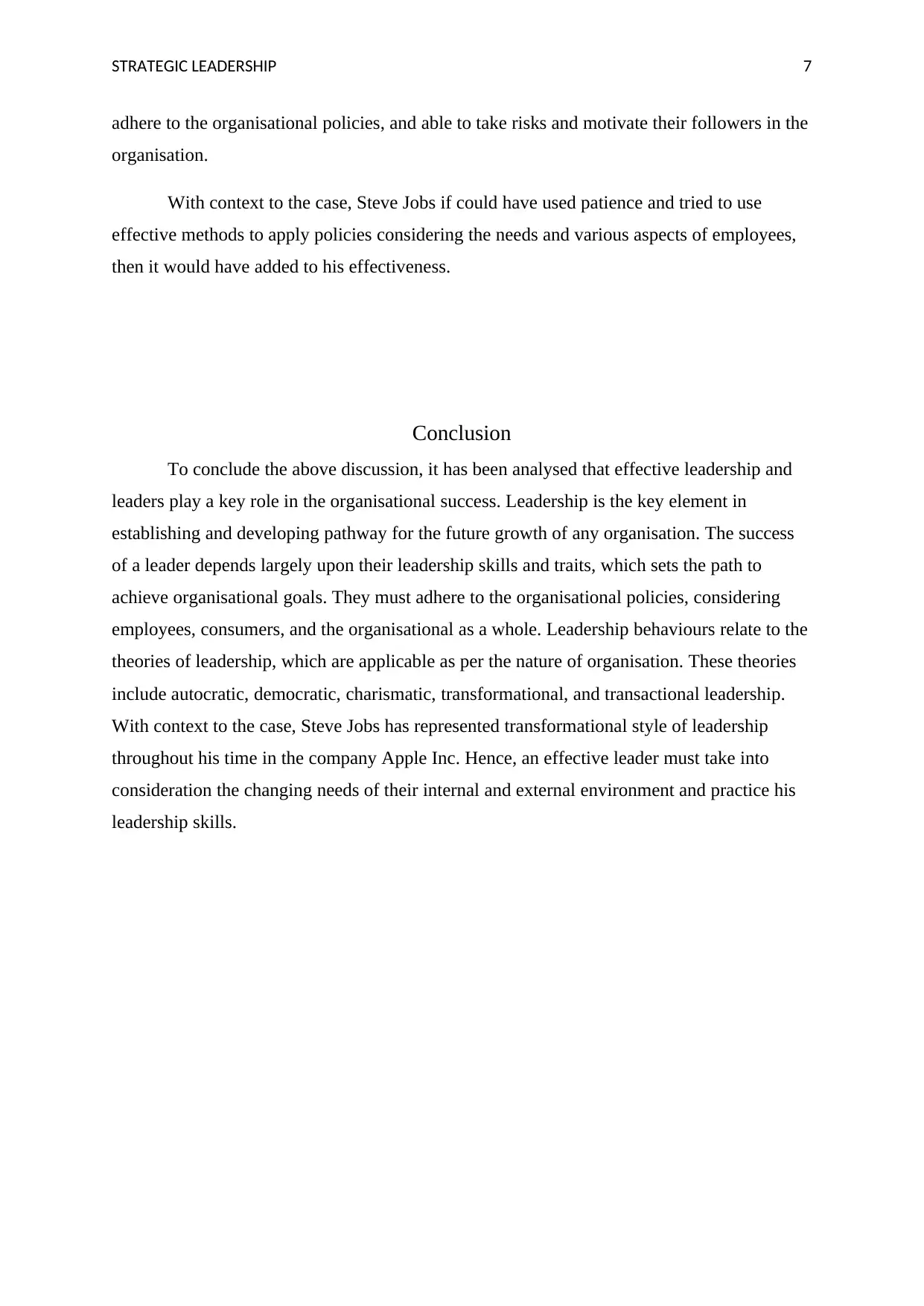
STRATEGIC LEADERSHIP 7
adhere to the organisational policies, and able to take risks and motivate their followers in the
organisation.
With context to the case, Steve Jobs if could have used patience and tried to use
effective methods to apply policies considering the needs and various aspects of employees,
then it would have added to his effectiveness.
Conclusion
To conclude the above discussion, it has been analysed that effective leadership and
leaders play a key role in the organisational success. Leadership is the key element in
establishing and developing pathway for the future growth of any organisation. The success
of a leader depends largely upon their leadership skills and traits, which sets the path to
achieve organisational goals. They must adhere to the organisational policies, considering
employees, consumers, and the organisational as a whole. Leadership behaviours relate to the
theories of leadership, which are applicable as per the nature of organisation. These theories
include autocratic, democratic, charismatic, transformational, and transactional leadership.
With context to the case, Steve Jobs has represented transformational style of leadership
throughout his time in the company Apple Inc. Hence, an effective leader must take into
consideration the changing needs of their internal and external environment and practice his
leadership skills.
adhere to the organisational policies, and able to take risks and motivate their followers in the
organisation.
With context to the case, Steve Jobs if could have used patience and tried to use
effective methods to apply policies considering the needs and various aspects of employees,
then it would have added to his effectiveness.
Conclusion
To conclude the above discussion, it has been analysed that effective leadership and
leaders play a key role in the organisational success. Leadership is the key element in
establishing and developing pathway for the future growth of any organisation. The success
of a leader depends largely upon their leadership skills and traits, which sets the path to
achieve organisational goals. They must adhere to the organisational policies, considering
employees, consumers, and the organisational as a whole. Leadership behaviours relate to the
theories of leadership, which are applicable as per the nature of organisation. These theories
include autocratic, democratic, charismatic, transformational, and transactional leadership.
With context to the case, Steve Jobs has represented transformational style of leadership
throughout his time in the company Apple Inc. Hence, an effective leader must take into
consideration the changing needs of their internal and external environment and practice his
leadership skills.
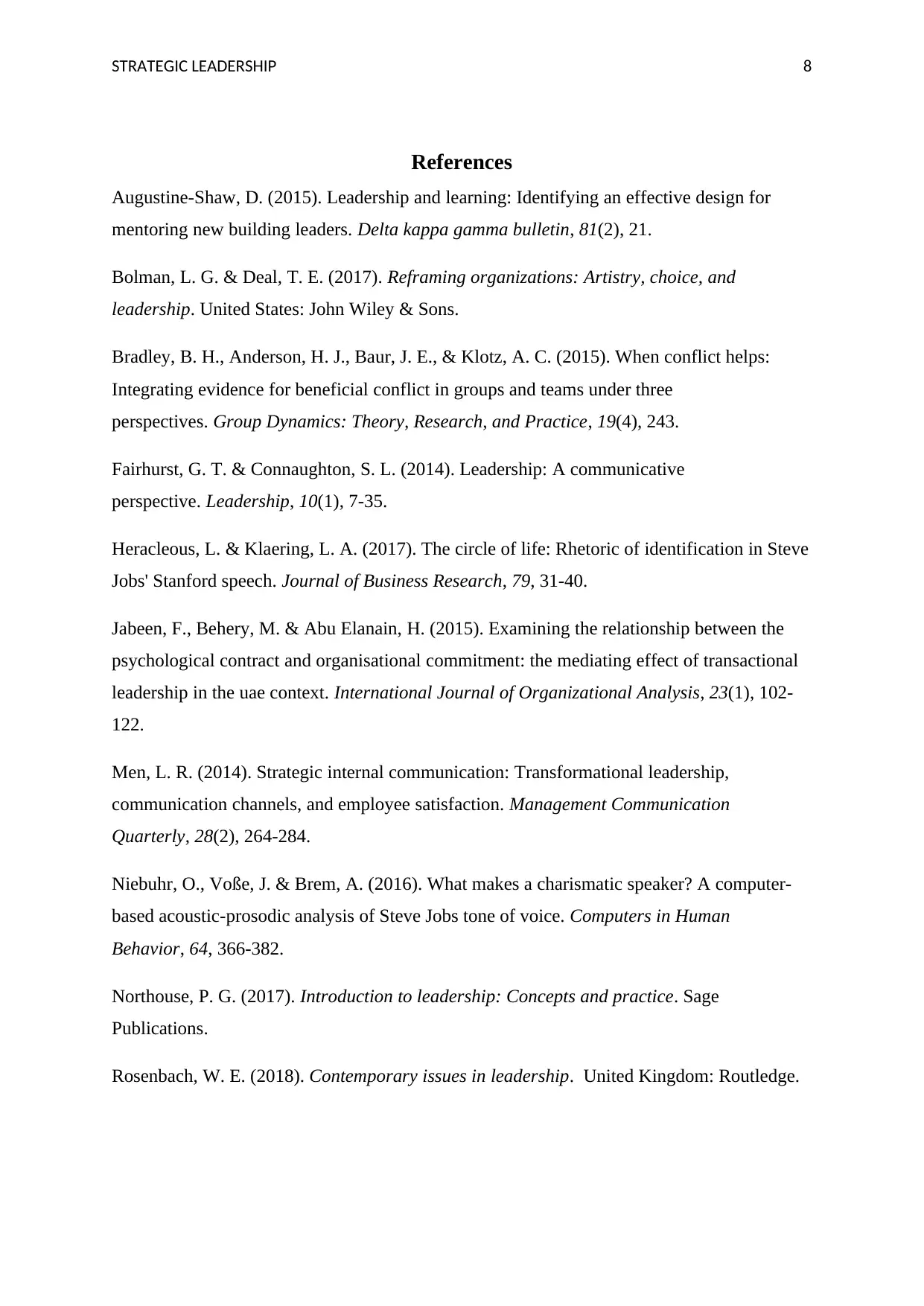
STRATEGIC LEADERSHIP 8
References
Augustine-Shaw, D. (2015). Leadership and learning: Identifying an effective design for
mentoring new building leaders. Delta kappa gamma bulletin, 81(2), 21.
Bolman, L. G. & Deal, T. E. (2017). Reframing organizations: Artistry, choice, and
leadership. United States: John Wiley & Sons.
Bradley, B. H., Anderson, H. J., Baur, J. E., & Klotz, A. C. (2015). When conflict helps:
Integrating evidence for beneficial conflict in groups and teams under three
perspectives. Group Dynamics: Theory, Research, and Practice, 19(4), 243.
Fairhurst, G. T. & Connaughton, S. L. (2014). Leadership: A communicative
perspective. Leadership, 10(1), 7-35.
Heracleous, L. & Klaering, L. A. (2017). The circle of life: Rhetoric of identification in Steve
Jobs' Stanford speech. Journal of Business Research, 79, 31-40.
Jabeen, F., Behery, M. & Abu Elanain, H. (2015). Examining the relationship between the
psychological contract and organisational commitment: the mediating effect of transactional
leadership in the uae context. International Journal of Organizational Analysis, 23(1), 102-
122.
Men, L. R. (2014). Strategic internal communication: Transformational leadership,
communication channels, and employee satisfaction. Management Communication
Quarterly, 28(2), 264-284.
Niebuhr, O., Voße, J. & Brem, A. (2016). What makes a charismatic speaker? A computer-
based acoustic-prosodic analysis of Steve Jobs tone of voice. Computers in Human
Behavior, 64, 366-382.
Northouse, P. G. (2017). Introduction to leadership: Concepts and practice. Sage
Publications.
Rosenbach, W. E. (2018). Contemporary issues in leadership. United Kingdom: Routledge.
References
Augustine-Shaw, D. (2015). Leadership and learning: Identifying an effective design for
mentoring new building leaders. Delta kappa gamma bulletin, 81(2), 21.
Bolman, L. G. & Deal, T. E. (2017). Reframing organizations: Artistry, choice, and
leadership. United States: John Wiley & Sons.
Bradley, B. H., Anderson, H. J., Baur, J. E., & Klotz, A. C. (2015). When conflict helps:
Integrating evidence for beneficial conflict in groups and teams under three
perspectives. Group Dynamics: Theory, Research, and Practice, 19(4), 243.
Fairhurst, G. T. & Connaughton, S. L. (2014). Leadership: A communicative
perspective. Leadership, 10(1), 7-35.
Heracleous, L. & Klaering, L. A. (2017). The circle of life: Rhetoric of identification in Steve
Jobs' Stanford speech. Journal of Business Research, 79, 31-40.
Jabeen, F., Behery, M. & Abu Elanain, H. (2015). Examining the relationship between the
psychological contract and organisational commitment: the mediating effect of transactional
leadership in the uae context. International Journal of Organizational Analysis, 23(1), 102-
122.
Men, L. R. (2014). Strategic internal communication: Transformational leadership,
communication channels, and employee satisfaction. Management Communication
Quarterly, 28(2), 264-284.
Niebuhr, O., Voße, J. & Brem, A. (2016). What makes a charismatic speaker? A computer-
based acoustic-prosodic analysis of Steve Jobs tone of voice. Computers in Human
Behavior, 64, 366-382.
Northouse, P. G. (2017). Introduction to leadership: Concepts and practice. Sage
Publications.
Rosenbach, W. E. (2018). Contemporary issues in leadership. United Kingdom: Routledge.
⊘ This is a preview!⊘
Do you want full access?
Subscribe today to unlock all pages.

Trusted by 1+ million students worldwide
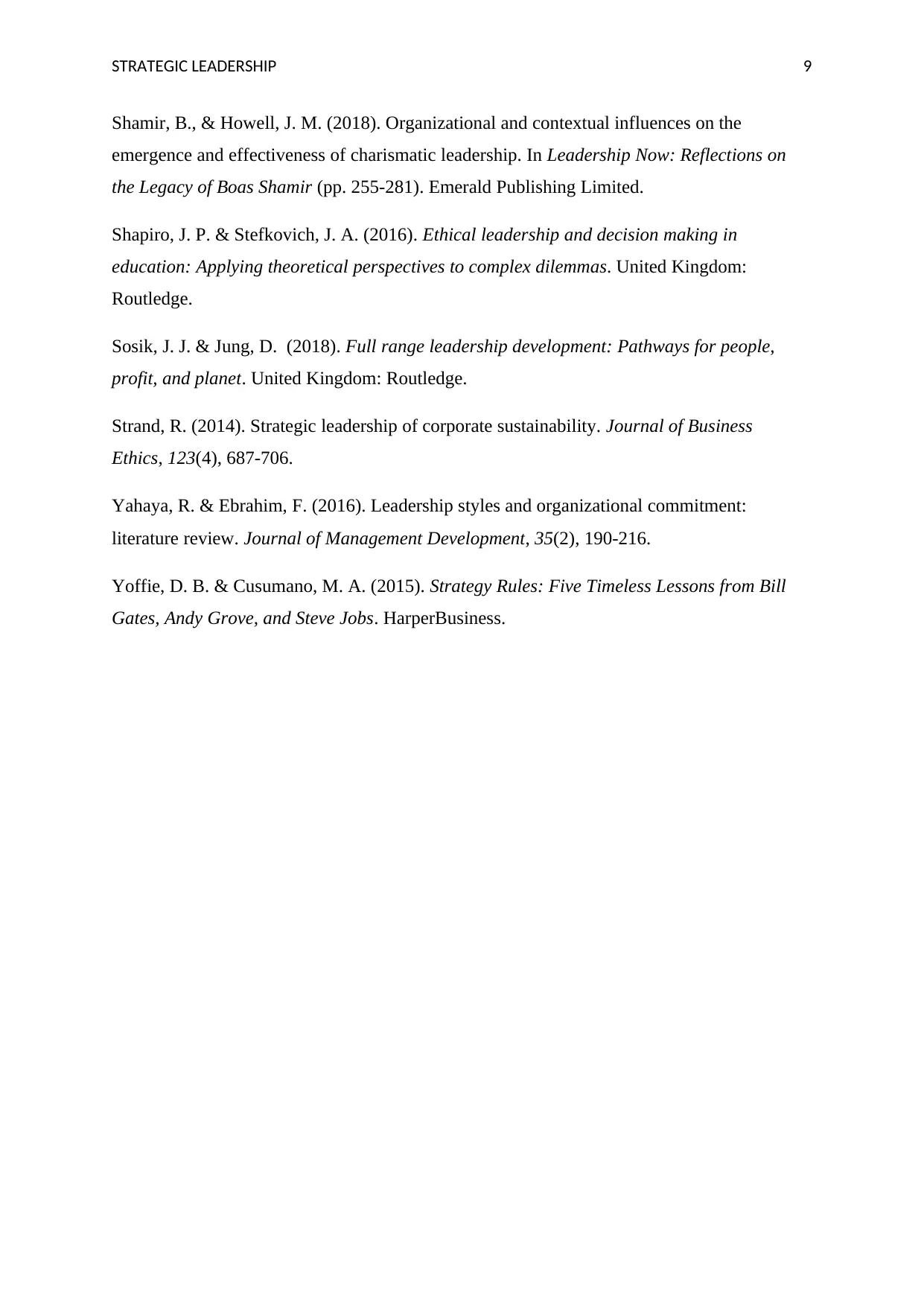
STRATEGIC LEADERSHIP 9
Shamir, B., & Howell, J. M. (2018). Organizational and contextual influences on the
emergence and effectiveness of charismatic leadership. In Leadership Now: Reflections on
the Legacy of Boas Shamir (pp. 255-281). Emerald Publishing Limited.
Shapiro, J. P. & Stefkovich, J. A. (2016). Ethical leadership and decision making in
education: Applying theoretical perspectives to complex dilemmas. United Kingdom:
Routledge.
Sosik, J. J. & Jung, D. (2018). Full range leadership development: Pathways for people,
profit, and planet. United Kingdom: Routledge.
Strand, R. (2014). Strategic leadership of corporate sustainability. Journal of Business
Ethics, 123(4), 687-706.
Yahaya, R. & Ebrahim, F. (2016). Leadership styles and organizational commitment:
literature review. Journal of Management Development, 35(2), 190-216.
Yoffie, D. B. & Cusumano, M. A. (2015). Strategy Rules: Five Timeless Lessons from Bill
Gates, Andy Grove, and Steve Jobs. HarperBusiness.
Shamir, B., & Howell, J. M. (2018). Organizational and contextual influences on the
emergence and effectiveness of charismatic leadership. In Leadership Now: Reflections on
the Legacy of Boas Shamir (pp. 255-281). Emerald Publishing Limited.
Shapiro, J. P. & Stefkovich, J. A. (2016). Ethical leadership and decision making in
education: Applying theoretical perspectives to complex dilemmas. United Kingdom:
Routledge.
Sosik, J. J. & Jung, D. (2018). Full range leadership development: Pathways for people,
profit, and planet. United Kingdom: Routledge.
Strand, R. (2014). Strategic leadership of corporate sustainability. Journal of Business
Ethics, 123(4), 687-706.
Yahaya, R. & Ebrahim, F. (2016). Leadership styles and organizational commitment:
literature review. Journal of Management Development, 35(2), 190-216.
Yoffie, D. B. & Cusumano, M. A. (2015). Strategy Rules: Five Timeless Lessons from Bill
Gates, Andy Grove, and Steve Jobs. HarperBusiness.
1 out of 10
Related Documents
Your All-in-One AI-Powered Toolkit for Academic Success.
+13062052269
info@desklib.com
Available 24*7 on WhatsApp / Email
![[object Object]](/_next/static/media/star-bottom.7253800d.svg)
Unlock your academic potential
Copyright © 2020–2025 A2Z Services. All Rights Reserved. Developed and managed by ZUCOL.




